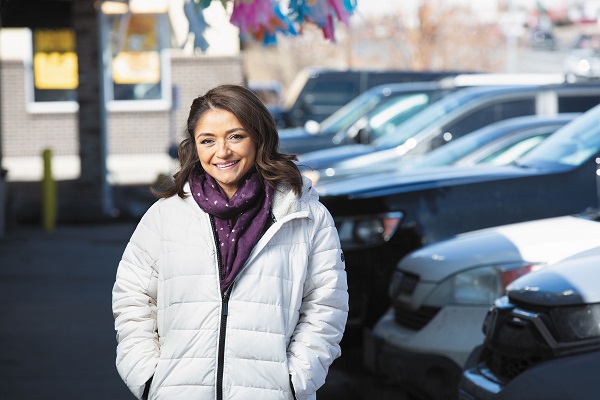Road Ready: Offering Auto Insurance to Families with Teenage Drivers

By: Will Jones
Learning to drive is one of the first milestones on the road to adulthood. It means freedom, independence and autonomy. It is a rite of passage. For parents of new drivers, it brings stress, worry and a hefty hit to their monthly auto insurance premium.
Before the pandemic skewed driving statistics, the fatal crash rate per mile driven by 16- to 19-year-olds was nearly three times the rate for drivers 20 and older, according to the Insurance Institute for Highway Safety (IIHS). With risk at its highest for drivers age 16-17, so is the cost of auto insurance.
In 2020, the average cost to insure a 16-year-old driver for the year was $5,744—$479 per month—according to The Zebra. That’s 289% higher than the national average of $1,483 across all ages. In many cases, the cost of car insurance exceeds monthly payments for a car or student loan.
For independent insurance agents and their customers, the cost and risks associated with insuring teen drivers is a challenge to navigate. However, Saida Perez-Garrido, owner of GIS Insurance Services in Thornton, Colorado, doesn’t see it that way, noting that “I don’t see challenges, I see opportunities. In today’s market, there is an avenue to insure teenagers individually or with their family. The price of insuring a teenager is high, but not as high as paying for an accident out of pocket.”
“For 21 years, I’ve insured single guys who got married, had children—I’ve seen them grow up and now I insured them—it’s a wonderful feeling,” Perez-Garrido says.
GIS Insurance Services writes 40% personal lines and has a client base that is 70% Hispanic. As a Guatemalan immigrant who immigrated to the U.S. in 1989, “I enjoy working with the Hispanic community,” Perez-Garrido says. “I have it imprinted in my heart. It runs in my veins. I go above and beyond to help them and to guide them.”
Outside of insurance, Perez-Garrido serves the Hispanic community in other ways. As the founder of Alianza Migrante Guatemalteca (Guatemalan Immigrant Alliance in Colorado), she and several other organizations advocated for the successful passage of the Colorado Road and Community Safety Act (SB251) in 2008, which provided driver’s licenses to all Colorado residents, regardless of immigration status. “This bill was crucial for us in the insurance industry,” Perez-Garrido says.
Additionally, in 2003, Alianza Migrante Guatemalteca joined other organizations to successfully advocate for the matricula—a photo identification card issued by the Mexican and Guatemalan government—to be recognized as a valid form of identification in the state.
“In our agency we take pride in helping our clients with anything that they need,” Perez-Garrido says, pictured (right) with her daughter, Z. Esther Rodriguez-Perez, who also works at the agency. “We guide them. We teach them. We hold their hand and we’re always here to help with their insurance needs.”
 Perez-Garrido also says that some of her clients neglect to add new drivers to the auto policy and some do not apply for a driver’s license at all. “Having the opportunity to represent several companies that insure drivers with a U.S. license or matricula from their country is extremely important,” she says. “Our agency diligently reviews that our insureds have every driver insured.”
Perez-Garrido also says that some of her clients neglect to add new drivers to the auto policy and some do not apply for a driver’s license at all. “Having the opportunity to represent several companies that insure drivers with a U.S. license or matricula from their country is extremely important,” she says. “Our agency diligently reviews that our insureds have every driver insured.”
In 2020, the Hispanic population in the U.S. reached 62.1 million, up from 50.5 million in 2010, according to the Pew Research Center. Further, Hispanic buying power has grown substantially—from $213 billion in 1990 to $1.9 trillion in 2020, accounting for 11.1% of total U.S. buying power, according to a report by the University of Georgia. This reveals an opportunity for all independent agents.
In 2021, Trusted Choice® launched the Big Picture campaign, which provides Big “I” members with personal and commercial lines marketing materials in English and Spanish. And help is never too far away from company partners either.
“The wonderful thing about representing all these different companies is that they all offer free marketing materials,” Perez-Garrido says. “I take advantage of all the marketing materials that the companies give me and give credit to the companies that are providing things in English and Spanish.”
Driving You Mad
All across America, drivers are feeling the pinch on various levels. In January 2022, inflation rose 7.5% compared to a year prior, according to the U.S. Department of Labor, which marked the highest rate since 1982. Meanwhile, in March 2022, the price of gas hit $4.331 per gallon, according to American Automobile Association data.
Further, auto insurance rates are expected to rise by an average of around 0.6% during 2022, with residents in 22 states seeing boosts of 1% or more, according to ValuePenguin’s State of Auto Insurance report. The report also predicted that premiums will continue to rise through 2023 as Americans return to their pre-pandemic patterns.
As the parents of first-time drivers prepare to purchase insurance, the conversation with their agent quickly turns to cost. And that is often the determining factor in their buying decision. Faced with sticker shock, they often take their insurance decisions into their own hands.
“One of the big topics is whose name is the vehicle titled in,” explains Karen O’Connor Corrigan, co-owner and president of O’Connor Insurance Agency in St. Louis and chair of the Big “I” Technical Affairs Committee. “The parents don’t always appreciate how important ownership is to the insurable interest, which is the necessary part to trigger coverage.”
“Some parents have this preconceived notion that by titling the vehicle in the teen’s name it eliminates the parental liability,” O’Connor Corrigan says. “But then on the flip side, parents think it’s cheaper to insure it under the parents’ policy, which means we have a policy issue because the parent doesn’t have an insurable interest.”
Price sensitivity also leads parents to be less than honest with their agent in a misguided attempt to save money. “Parents will often try to skirt around the issue and say that their child is ‘thinking about getting their license’ because they want to find out how much it will cost,” O’Connor Corrigan says. However, failing to disclose a licensed driver living at the insured’s residence could land parents in hot water, especially now that some carriers are aggressively pursuing undisclosed operators via publicly available information.
“Getting the proper information is the greatest challenge because parents are trying to do things to get the least expensive policies,” O’Connor Corrigan says. “We certainly don’t want an accident with an unreported licensed driver in the household.”
As common as it is for parents to bend the truth with their agent, what’s just as common is kids lying to their parents about how they are using their newfound freedom. While lying to your parents is an age-old story, it can have serious insurance-related consequences in the event of an auto accident.
Specifically, whether they are still at home or a freshman in college, teen drivers aren’t telling their parents that they are working for DoorDash, Uber or other platforms, “which create exposures that aren’t covered by the policies they have,” says Andy Siegel, president of Siegel Insurance in Atlanta, past president of the Independent Insurance Agents of Georgia (IIAG) and co-chair of IIAG personal lines technical committee. “We can discuss the risk and the policy can be endorsed,” he says. “But the problem is that the kids just aren’t telling their parents about it.”
Another problem is when teens are letting their friends drive or borrow their car. “We always explain that the insurance follows the car—whoever owns the car is legally liable for someone being hurt,” Siegel says. “If one of the kids has loaned it out to someone, it puts the parents’ liability and their assets at risk.”
And in that situation, lacking high limits of liability and an umbrella policy leaves a gaping hole in many insurance policies. “An umbrella policy also protects against negligent entrustment and vicarious liability claims,” says Brook McGuire, product strategy lead, Safeco Insurance. “Many young drivers would think nothing about handing the keys to a friend and negligent entrustment comes into play when things like an unlicensed operator, alcohol or late-night driving are involved.”
Importantly for families, a teenager at college is still considered a resident relative and is therefore covered by the parent’s policy. “But once they finish school and they’re living elsewhere, they need to get something separate from mom and dad’s policy,” Siegel says. “We’re recommending named nonowner policies for those kids who drive and have moved out of their parents home but don’t own vehicles—it’s part of the process of what happens to insure the next generation.”
Education Without Distraction
Insurance aside, a total of 2,375 teenagers ages 13-19 died in motor vehicle crashes in 2019, according to IIHS. Their research also shows that the crash rate per mile driven for drivers 16 -19 years old is 4 times that of drivers 20 and older, and the fatal crash rate per mile is 3 times that of drivers 20 and older.
With these figures in mind, it stands to reason why teen auto insurance rates are so high. However, the most important question remains: How can parents, agents and insurers partner to make driving safer for young drivers and reduce crashes and fatalities?
One tactic is understanding the risky behaviors that young drivers are more likely to engage in. “One of the risks that we see cause accidents is the immaturity of young drivers to recognize hazards on the road,” says Don Tardif, assistant vice president of product management at Travelers. “Another is the higher propensity for speeding.”
In 2019, 31% of male drivers ages 15-20 and 17% of female drivers ages 15-20 who were involved in fatal crashes were speeding, according to the National Highway Traffic Safety Administration (NHTSA). Additionally, nighttime driving is riskier than daytime driving for drivers of all ages but is particularly dangerous for teen drivers. In 2019, 40% of motor vehicle crash deaths among teens ages 13-19 occurred between 9 p.m. and 6 a.m. and 52% occurred on Friday, Saturday or Sunday, according to the IIHS’s “Fatality Facts 2019: Teenagers” study.
While self-driving cars are still a long way away from being integrated onto U.S. roads, growing technology is making some strides to create a safer environment. “The advent of auto emergency braking and lane correction are making cars safer. As more vehicles become equipped with this technology it will reduce minor accidents over time,” Tardif says. “Some manufacturers have teenage driving apps and a ‘youthful key,’ which can monitor driving behaviors like speed or can prevent drivers from turning on the radio if they don’t have their seatbelt on.”
Meanwhile, one of the most pervasive risky behaviors that young drivers engage in is distracted driving. In 2021, the Travelers Risk Index, a survey of 1,000 respondents across age groups, found that a growing number of Americans are using their mobile devices in unsafe ways while driving, including texting or emailing (26%, up from 19% pre-pandemic), checking social media (20%, up from 13% pre-pandemic), taking videos and pictures (19%, up from 10% pre-pandemic), and shopping online (17%, up from 8% pre-pandemic).
However, among young drivers, these figures could be even higher based on results from the 2019 national Youth Risk Behavior Survey. The survey revealed that among U.S. high school students who drove, 39% texted or e-mailed while driving at least once during the 30 days before the survey.
Texting while driving is the most dangerous distraction on the roads today, according to the NHTSA, which says sending or reading a text can take your eyes off the road for up to five seconds—the equivalent of driving the entire length of a football field with your eyes shut.
“The issue is that a modern-day smartphone is not just a telephone, it’s a small computer that can access social media, videos, games and the internet, so the device is far more of a distraction than the old analog phones,” explains Joe Stewart, vice president for governmental affairs at the Independent Insurance Agents of North Carolina Inc. (IIANC). IIANC advocates for SB20 in the North Carolina legislature, which would make it unlawful for a driver to hold a wireless communication device in their hands while operating a motor vehicle.
“For younger people today, communicating electronically with their friends and staying in touch with what’s going on in the world through these devices has been a whole-life experience—it is not a secondary habit. The urge to pick up their smartphone is a constant,” Stewart says. “So when they get behind the wheel of a car, it’s not as though they suddenly decide to check social media, it’s just an extension of the rest of their day—they just happen to be behind the wheel.”
Communicating the risk of distracted driving is difficult. “To win over future generations, we’ve got to go to where they are rather than expecting them to come to us,” Tardif says, noting that Travelers’ distracted driving campaign features “Unfinished Stories,” which is an animated series of educational videos that “keeps the kids engaged, has a positive outlook and most importantly, provides a healthy education on what distracted driving can mean for the family.”
In North Carolina, Stewart recommends a program called StreetSafe (streetsafeus.com), which combines classroom instruction and driving sessions. “But a requirement is that parents have to be present for the first part of it,” Stewart says. “Instructors explain the effective role a parent must play to support good driving behavior, so the instruction provided to the young driver takes hold, and is not just another conversation mom or dad are having with a kid.”
Graduated driver licensing (GDL) systems can also make the roads safer for teenagers. GDLs initially restrict the driving privileges of new drivers. As they gain driving experience and competencies, the restrictions are removed, typically in three stages. Those stages begin with a learner’s permit, followed by an intermediate stage or provisional license, and then a full license.
“A lot of the mistakes that young drivers make are just based on a lack of understanding of the physics of driving, such as how long it takes a car to stop at certain speeds and what is going to happen in terms of having to respond to something unanticipated coming up on the roadway,” Stewart says. “Those kinds of programs are really beneficial for young people who are interested in learning more about how they can be better drivers.”
Also, “compared to prior generations, today’s youth increasingly value justice and fairness,” McGuire explains. “One way to educate them is to contextualize the responsibility of driving. Young drivers will struggle to connect their driving habits today with a fuzzy notion of an accident, especially if no one they know has been involved in a major collision. What they will understand is specific examples of claims involving young people.”
“They will understand the financial and emotional ramifications to their families if they’re sued,” McGuire adds. “And they will definitely understand the impact of medical bills, injuries, disability or death to passengers in their vehicle or occupants of another vehicle.”
For agents, the benefit of engaging with young drivers could be exponential because, typically, when a young driver is getting their license, they have other life milestones that will follow soon after. “Establishing yourself as a reliable expert—someone who not only answers their questions but offers proactive advice—is invaluable when creating a long-term relationship with a young driver,” says Jeff Rommel, senior vice president of P&C sales and distribution, Nationwide.
“This is a great opportunity to get them thinking about what insurance needs will be coming up,” he says. “You can talk about protecting their belongings whether in a dorm or an apartment—the key is to listen carefully as they talk about their future with you.”
Will Jones is IA editor-in-chief.
Teens and TelematicsOne tool that can have a meaningful impact on young drivers’ safety is a telematics program. “Young drivers have grown up with cell phones and digital everything. Many spend hours a day looking at their devices,” McGuire says. “A telematics app is tangible and meets young drivers where they’re most comfortable.” Further, the objective data that an app provides can help parents have proactive conversations with their young driver before something bad happens. “Parents—or insurance agents—can have meaningful conversations about driving behavior by reviewing their exceptions,” McGuire adds. “Making them aware of their hard braking, late-night driving and rapid acceleration incidents is helpful.”—WJ |










